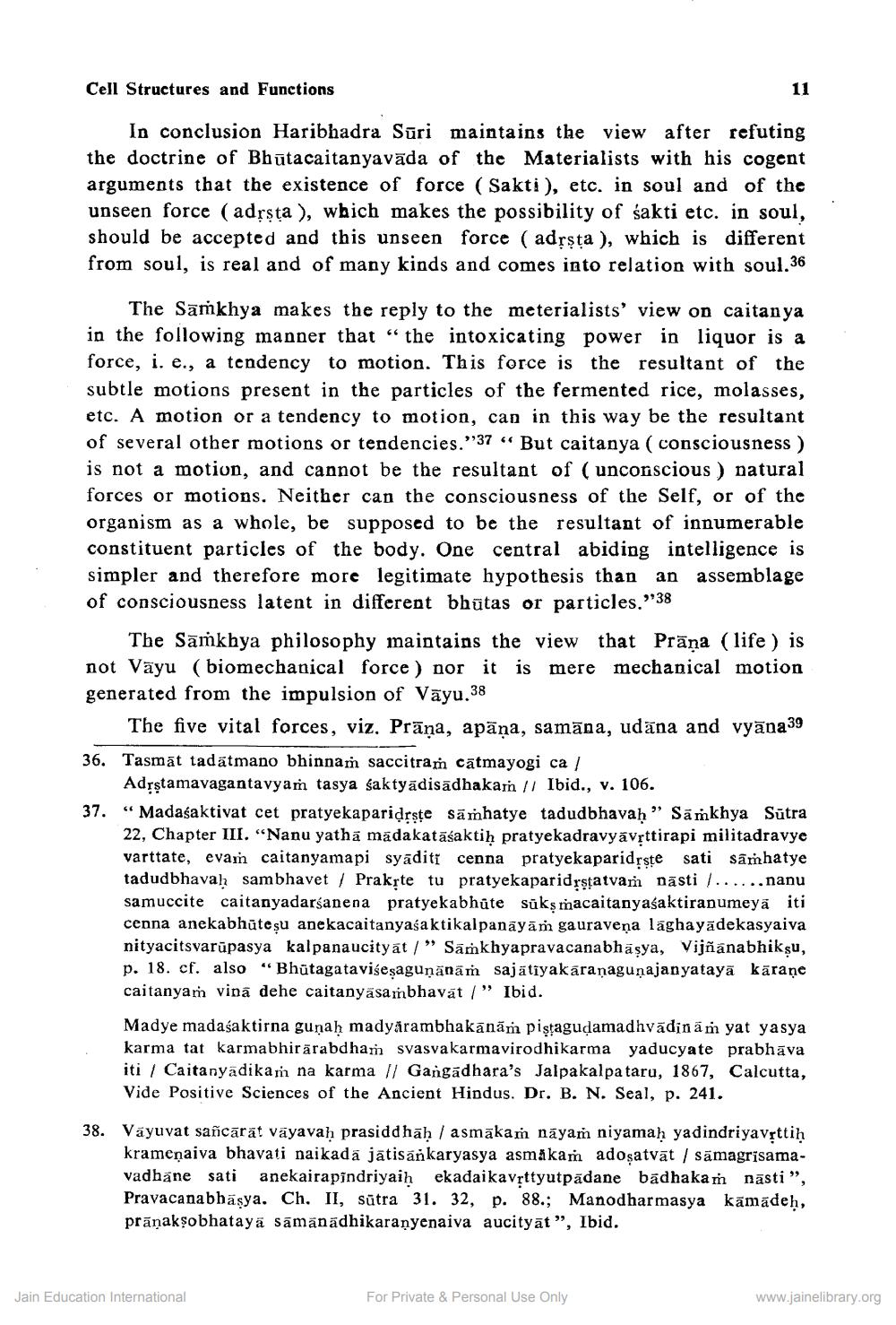________________
Cell Structures and Functions
In conclusion Haribhadra Sūri maintains the view after refuting the doctrine of Bhūtacaitanyavāda of the Materialists with his cogent arguments that the existence of force (Sakti), etc. in soul and of the unseen force (adrsta ), which makes the possibility of sakti etc. in soul, should be accepted and this unseen force (adrsta ), which is different from soul, is real and of many kinds and comes into relation with soul.36
The Samkhya makes the reply to the meterialists' view on caitanya in the following manner that “the intoxicating power in liquor is a force, i. e., a tendency to motion. This force is the resultant of the subtle motions present in the particles of the fermented rice, molasses, etc. A motion or a tendency to motion, can in this way be the resultant of several other motions or tendencies."37 “But caitanya (consciousness ) is not a motion, and cannot be the resultant of (unconscious) natural forces or motions. Neither can the consciousness of the Self, or of the organism as a whole, be supposed to be the resultant of innumerable constituent particles of the body. One central abiding intelligence is simpler and therefore more legitimate hypothesis than an assemblage of consciousness latent in different bhūtas or particles."38
The Samkhya philosophy maintains the view that Prāna (life ) is not Vāyu (biomechanical force ) nor it is mere mechanical motion generated from the impulsion of Vāyu.38
The five vital forces, viz. Prāna, apāna, samāna, udāna and vyāna39 36. Tasmāt tadatmano bhinnam saccitram catmayogi ca
Adịştamavagantavyam tasya saktyādisādhakar 11 Ibid., v. 106. 37. “Madagaktivat cet pratyekaparidrste samhatye tadudbhavah” Samkhya Sūtra
22, Chapter III. “Nanu yatha madakatāsaktih pratyekadravyavrttirapi militadravye varttate, evam caitanyamapi syāditi cenna pratyekaparidrste sati Samhatye tadudbhavah sambhavet / Prakrte tu pratyekaparidrstatvam Dāsti /......nanu samuccite caitanyadarśanena pratyekabhūte sūkş macaitanyasaktiranumeya iti cenna anekabhūteşu ane kacaitanyasaktikalpanāyāṁ gauraveņa lāghayadekasyaiva nityacitsvarūpasya kalpanaucityát/" Samkhyapravacanabhāşya, Vijñānabhikṣu, p. 18. cf. also "Bhutagatavisesaguņānām sajatiyakaranagunajan yatayā kārane caitanyam vina dehe caitanyasambhavāt/" Ibid.
Madye madaśaktirna guṇaḥ madyarambhakānām pistagudamadhvādinām yat yasya karma tat karmabhirarabdham svasvakarmavirodhikarma yaducyate prabhāva iti 1 Caitanyadikam na karma // Gangadhara's Jalpakalpataru, 1867, Calcutta, Vide Positive Sciences of the Ancient Hindus. Dr. B. N. Seal, p. 241.
38. Vãyuvat sañcārät väyavah prasiddhāḥ / asmākam nāyam niyamah yadindriyavrttiḥ
kramenaiva bhavati naikada jätisankaryasya asmäkam adoşatvāt / samagrisamavadhäne sati anekairapîndriyaih ekadaikavrttyutpadane badhaka í násti", Pravacanabhāsya. Ch. II, Sūtra 31. 32, p. 88.; Manodharmasya kāmādeh, prānak sobhataya Samanadhikaranyenaiva aucityāt", Ibid.
Jain Education International
For Private & Personal Use Only
www.jainelibrary.org




